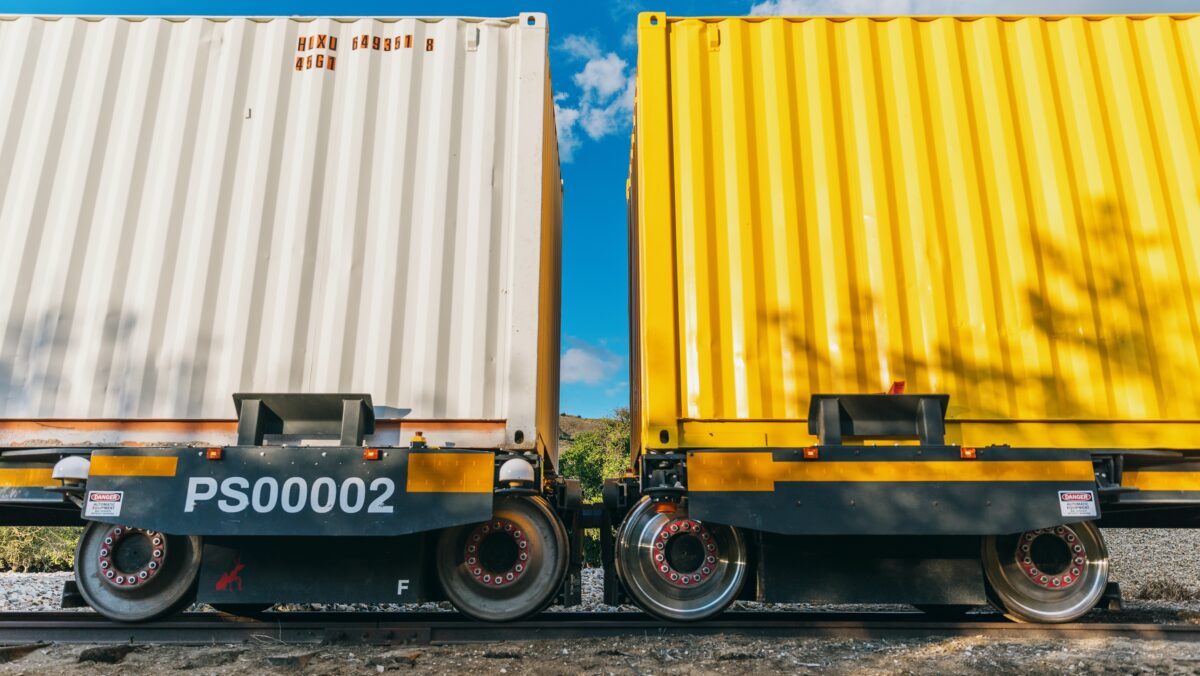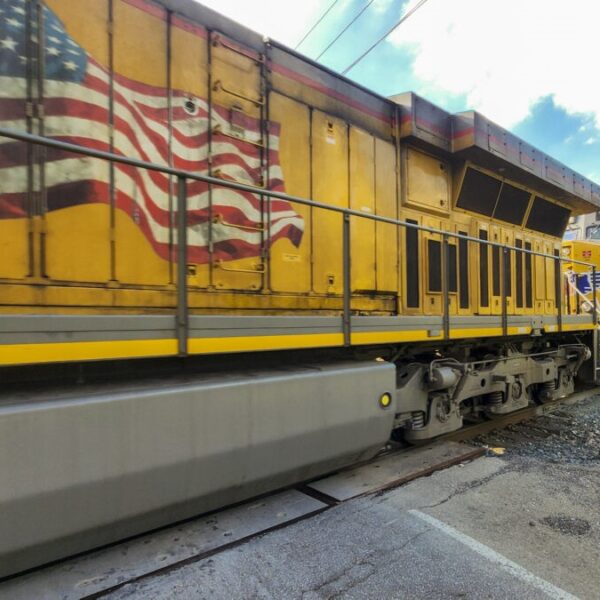An autonomous rail vehicle startup successfully demonstrated how its self-driving containers on wheels hook up, a key step toward long platoons of rail cars that can split apart to reach varied destinations.
Vehicles Link Up Bumper-to-Bumper
Parallel Systems, based in Los Angeles, announced that its autonomous rail cars maintained contact via their bumpers during recent testing at a California track. The company aims to form platoons of up to 50 rail vehicles that would compete with trucks for hauling freight.
Rather than using couplers and air hoses to link old-fashioned rail cars, Parallel’s two-wheeled vehicles stay connected through speed control and traction power. A small gap remains between the shipping containers riding atop each self-driving base. The push between bumpers cuts aerodynamic drag across the platoon versus hauling single containers.
“Our platoon testing began in October 2023, and the performance has been consistent with our modeling and simulations, which is exciting right out of the gate,” said Parallel Systems CEO Matt Soule. “The vehicles have remained connected according to plan, allowing us to plan expanded platoon testing with increased speeds, a greater number of vehicles, and braking.”
Bye-Bye Classification Yards?
Unique to Parallel technology, individual rail vehicles can detach from the platoon when needed. They would bypass traditional rail sorting yards and independently continue to disparate destinations. Or they may split off to keep crossings clear rather than blocking roads and pedestrians.
As a result, some rail facilities and their large land footprints could conceivably grow unnecessary in a future with autonomous rail cars.
The self-driving containers also brake independently without connections to adjacent units. Soule said platooning helps address nagging rail issues like congested yards and blocked crossings.
Global Rail Companies Express Interest
Parallel Systems’ has garnered attention from rail providers abroad and at home. Earlier this month, the firm announced plans with Australia’s Arc Infrastructure to develop a prototype wagon for future container operations in Perth.
Domestically, two short-line rail subsidiaries of Genesee & Wyoming sought federal permission to pilot Parallel’s tech on Georgia tracks.
The budding company shows how innovators aim to overhaul freight rail from the wheels up through automation. Legacy railroads are watching closely for what self-driving containers on slimmed down running gear could offer their services.
Game-Changing Benefits
If perfected, platoons of autonomous rail vehicles could provide substantial benefits beyond shedding yards and unblocking crossings.
The streamlined vehicles would allow more freight to fit in existing corridors. Containers could be grouped based on destination at origin for faster routing compared to sluggish, manual sorting mid-journey. Moving containers spend less downtime in transit if bypassing yards.
Parallel Systems says its rail vehicles will cut costs by at least 25% per container versus tractor-trailers on highways. Rail’s efficiency edge would further expand if achieving truck-like point-to-point delivery.
Technology could also help rail better serve customers wanting smaller, more flexible shipments versus massive trainloads. And self-driving vehicles may operate safer with multiple autonomous safety systems versus accident-prone human crews.
Massive Technical Hurdles
Yet realizing platoons of compact robotic rail cars requires conquering immense technical barriers.
Hardware must reliably support heavy containers at speeds up to 70 mph while securing close connections. Software must smoothly coordinate vehicles that both split off and congregate. Expanded testing will further validate Parallel’s simulations.
Regulatory approvals may pose nearly as great a challenge for autonomous innovation on public tracks. But select pilot projects suggest railroads want to encourage developers rather than obstruct them.
If the technology works dependably, fails safely and satisfies regulators, the company could fundamentally reshape U.S. freight infrastructure for the better. While still highly speculative, the vast promise makes Parallel’s incremental testing milestones noteworthy.
The startup’s early platoon demonstrations prove key building blocks function as envisioned on the path to futuristic freight. Whether the company’s full vision unfolds remains unclear. But after hooking up containers in California, autonomous rail just looks a bit more plausible.
By leveraging their expertise and resources, Lading Logistics aims to provide efficient and reliable international shipping and logistics solutions for their clients.



